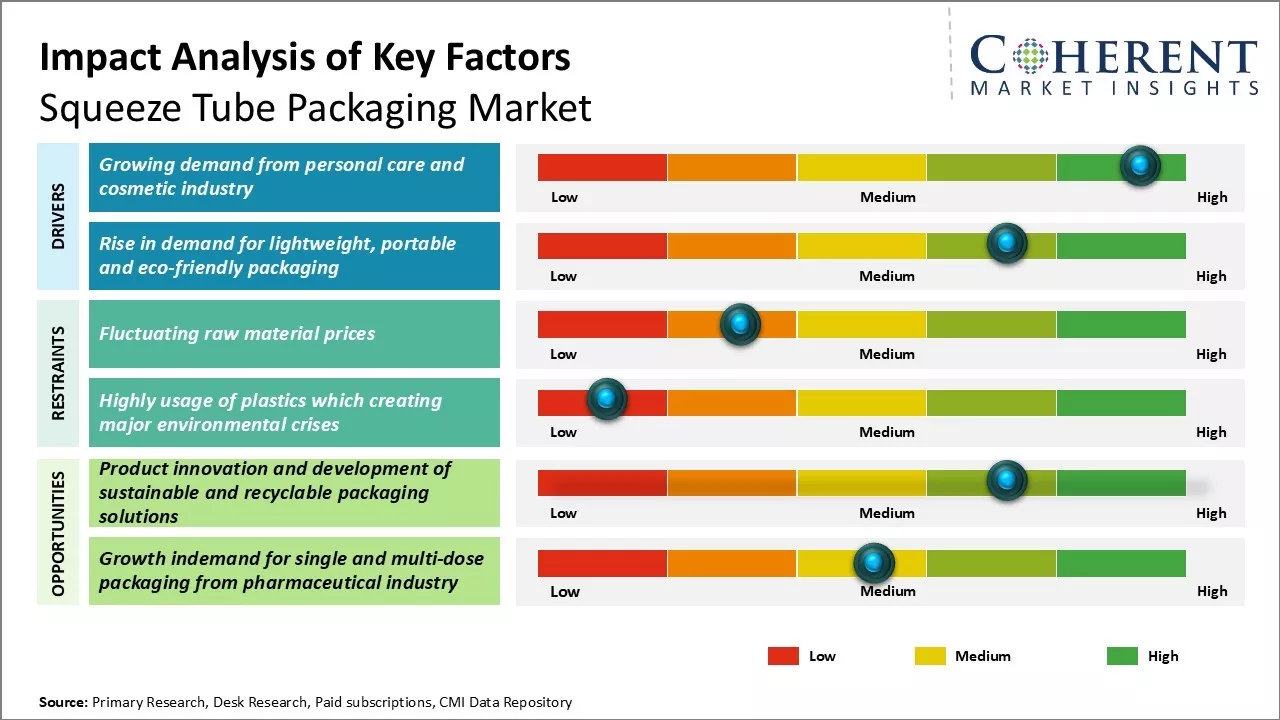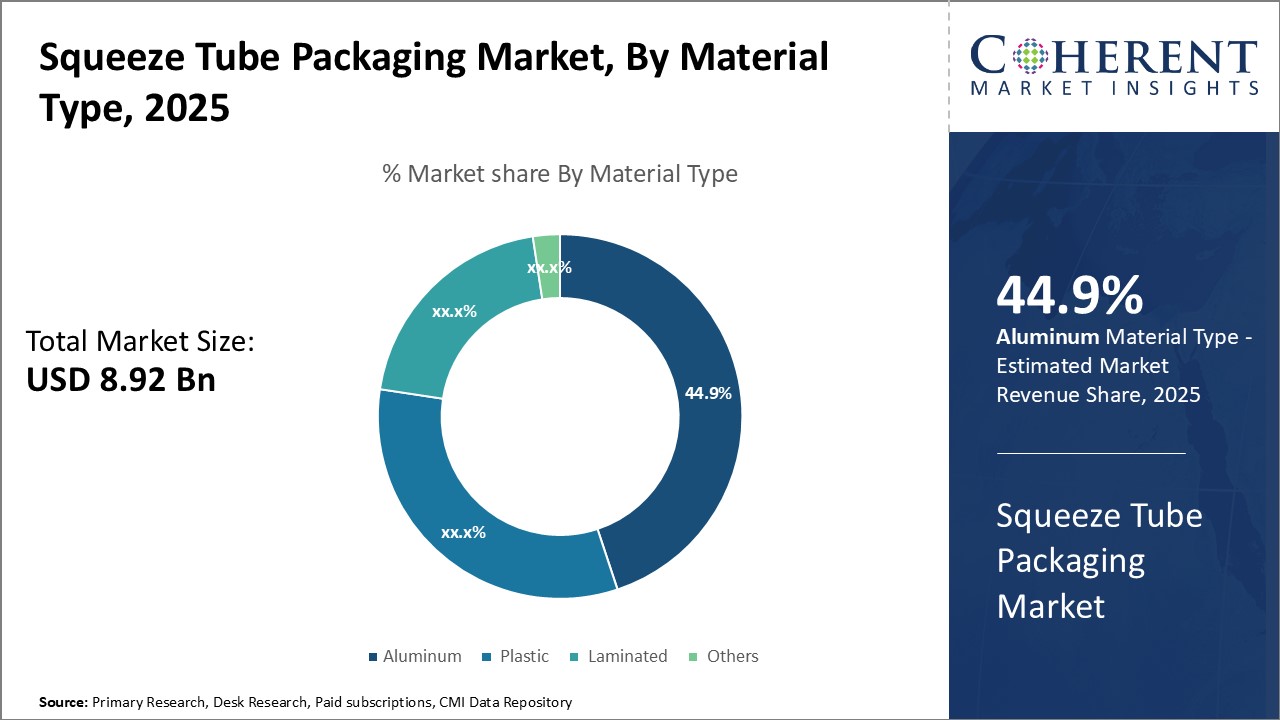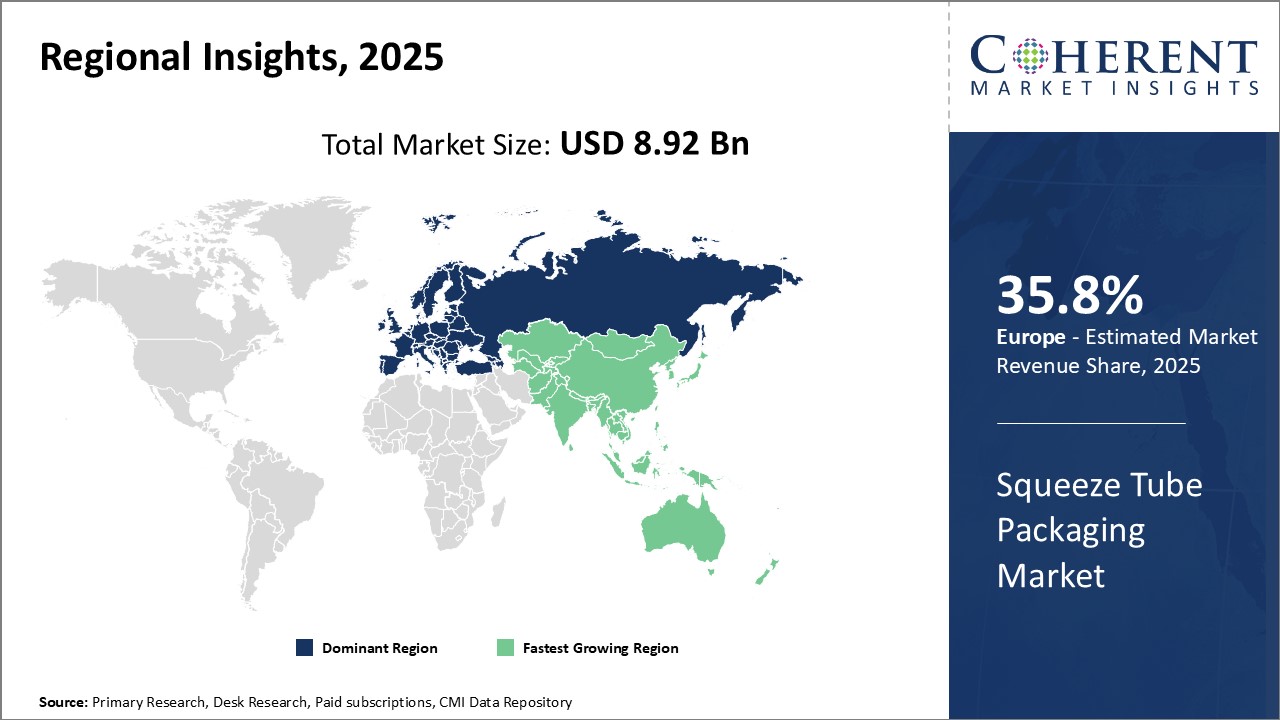The squeeze tube packaging market is estimated to be valued at USD 8.92 Bn in 2025 and is expected to reach USD 13.60 Bn by 2032, exhibiting a compound annual growth rate (CAGR) of 6.2% from 2025 to 2032.

Discover market dynamics shaping the industry: Download Free Sample
Rising demand from the skincare and cosmetics industry along with increasing preference for portable and travel-friendly packaging drives the market growth. Growing health and hygiene awareness post-COVID-19 pandemic has further propelled the demand for squeeze tubes from the handwash and sanitizer industry. Expanding retail channels especially e-commerce is also contributing to the market growth.

Discover high revenue pocket segments and roadmap to it: Download Free Sample
Insights, By Material Type: Affordability and Versatility Drive Aluminum's Dominance in Squeeze Tube Packaging Market
In terms of material type, the aluminum segment is expected to contribute 44.9% share of the market share in 2025. When it comes to material selection for squeeze tube packaging, aluminum offers manufacturers unparalleled versatility and cost-effectiveness. Aluminum tubes can be produced in a wide variety of sizes, from small introductory samples to larger single-use containers. They are lightweight yet durable, making them an economical option for products shipped domestically and internationally.
Aluminum is 100% recyclable and produces minimal waste during manufacturing compared to other materials. This eco-friendly attribute appeals strongly to brand owners seeking sustainable packaging solutions. It can be formed into intricately shaped tubes to showcase premium branding and graphics. Aluminum is also fully customizable with options for printing, coating, and embossing without compromising integrity or shelf life.
Insights By Application: Oral Care Drives Squeeze Tube Packaging Demand through Sample Distribution and Portability
In terms of application, oral care is expected to contribute 40.1% share of the market in 2025. Within the market, oral care enjoys the highest demand due to the segment's unique packaging needs. Squeeze tubes are perfectly suited for precisely dispensing and applying small doses of gels, pastes, and liquids onto toothbrushes.
Their portability makes squeeze tubes ideal vehicles for distributing introductory samples through dental offices, retailers, and direct mailings. This builds brand awareness while allowing consumers to trial new products. Squeeze tubes containing full-sized portions also lend convenience when brushing on the go or while traveling. Oral care formulations can be expensive to purchase in full-size formats before testing compatibility with one's oral health needs and tastes.

Need a Different Region or Segment? Download Free Sample
Regional Analysis: Squeeze Tube Packaging Market
Dominating Region: Europe
Europe is expected to account for the greatest revenue share, with 35.8% in 2025. In Europe, the dominance in the squeeze tube packaging market can be attributed to the strong presence of major manufacturers in countries like the U.K., Germany, etc. The region has a well-established market ecosystem and supply chain for personal care and healthcare products where squeeze tubes are widely used. Stringent packaging regulations provide impetus for innovation among tube makers to develop sustainable options.
Fastest-Growing Region: Asia Pacific
The Asia Pacific region exhibits the fastest growth in this market riding on the coat tails of expanding personal care and pharmaceutical industries. Developing economies like India and China contribute significantly to the regional growth owing to rising spending power, shift in lifestyle preferences, and growing health awareness.
Squeeze Tube Packaging Market Outlook for Key Countries
U.S.: Squeeze tube packaging market in the U.S. is driven by leading domestic brands with a focus on premium products packaged in innovative tube designs.
China: Squeeze tube packaging market growth in China outpaces other countries on account of a large population base and rapid urbanization.
India: India continues to lead the APAC market given its low manufacturing costs and a thriving domestic industry. Companies like Pratibha Industries and others stimulate market growth through extensive production capabilities.
Germany: Squeeze tube packaging market in Germany is supported by major global brands and stringent packaging norms that favor sustainable tube material options from suppliers like Airless.
Brazil: The market growth in the Brazil is growing alongside economic recovery and increasing health investments.
Top Strategies Followed by Squeeze Tube Packaging Market Players
Emerging Startups in the Squeeze Tube Packaging Market
Several startups are developing innovative technologies to disrupt this market. Some focus on incorporating smart sensors into tubes to enable traceability, collect usage data, and assist refills. Startups are also applying advanced analytics, computer vision, and Internet of things (IoT) to optimize packaging workflows.
Sustainability is a key area attracting startups. Some innovative companies are creating tubes from renewable, recycled, or compostable materials to reduce waste. Other startups offer sustainable tube filling and sealing equipment. Their eco-friendly solutions can significantly lower the industry's carbon footprint over time.
Many startups focusing on niche market needs by providing customized tubes for specific product categories such as cosmetics, pharmaceuticals, or healthcare. Some partner with manufacturers to develop innovative packaging for new product launches.
Key Takeaways from Analyst
Squeeze Tube Packaging Market Report Coverage
| Report Coverage | Details | ||
|---|---|---|---|
| Base Year: | 2024 | Market Size in 2025: | USD 8.92 Bn |
| Historical Data for: | 2020 To 2024 | Forecast Period: | 2025 To 2032 |
| Forecast Period 2025 to 2032 CAGR: | 6.2% | 2032 Value Projection: | USD 13.60 Bn |
| Geographies covered: |
|
||
| Segments covered: |
|
||
| Companies covered: |
Amcor Limited, Essel Propack Limited, Albea S.A., Huhtamaki OYJ, Berry Global Inc., Intrapac International Corporation, Montebello Packaging Inc., Worldwide Packaging Inc., Romaco Group, Hoffman Neopac AG, VisiPak, Sonoco Products Company, and Clariant |
||
| Growth Drivers: |
|
||
| Restraints & Challenges: |
|
||
Uncover macros and micros vetted on 75+ parameters: Get instant access to report
Market Driver - Growing demand from personal care and cosmetic industry
The personal care and cosmetics industry has been experiencing consistent growth in recent years. With increasing urbanization and rising disposable incomes, consumers are placing greater emphasis on personal grooming and self-care. Additionally, the fast-paced lifestyle has heightened the demand for convenient packaging solutions that are easy to use on the go. Squeeze tube packaging is an ideal option, providing controlled and hygienic dispensing for products such as face creams, hair serums, and toothpaste.
For instance, a Deloitte report presented during a Happi Webinar in June 2023 highlighted that the middle class in Africa has tripled over the past 30 years. While it is not the wealthy, approximately one in three people are now living above the poverty line. Current projections indicate that by 2060, Africa will see an increase of 1.1 billion people (42%) joining the middle class. Remarkably, seven of the ten fastest-growing economies in the world are located in Africa. According to Deloitte, wealth is increasingly being distributed, making Africa home to the world's fastest-growing middle class.
Market Challenge - Fluctuating raw material prices
The squeeze tube packaging sector is facing challenges due to fluctuating prices of raw materials used to manufacture tubes. Plastic polymers like Low Density Polyethylene (LDPE), Linear Low-Density Polyethylene (LLDPE), and aluminum, which are key raw materials, have witnessed high price volatility in the past year affecting packaging manufacturers. The uncertainty caused by changing prices makes it difficult for companies to arrive at optimal production cost. Moreover, plastic polymers are crude oil derivatives and fluctuations in global oil prices automatically impacts raw material costs. Sudden price hikes reduce profit margins, while drops in rates negatively impact the top-line of companies.
For example, during mid-2021 when input costs rose sharply, several personal care and food product manufacturers halted new squeeze tube packaging launches, preferring stable rigid plastic packaging instead. Manufacturers struggle to transfer increased costs to brand owners and end consumers directly leading to immediate loss of business. The unpredictability in sourcing crucial inputs at affordable rates poses significant squeeze tube packaging risks for participants.
Market Opportunity - Product innovation and development of sustainable and recyclable packaging solutions
The squeeze tube packaging sector sees huge opportunities through constant innovation and development of environment friendly products. As sustainability becomes a major purchase criterion, companies are investing in R&D to launch tubes made from renewable, recycled and recyclable materials. Bioplastics obtained from sugarcane or plant-based resins are gaining popularity.
For instance, according to United Nations Environment Programme (UNEP)reports from 2023, enabling reuse and improving recyclability are critical to curb plastic pollution which is projected to triple by 2040 if no action is taken. Innovation in squeeze tube design can thus have large positive impact on sustainability while future-proofing growth in the squeeze tube packaging sector. Efforts are also on to enhance the recyclability of aluminum tubes. Participants partner with brand owners proactively to replace non-recyclable multi-layer tubes.
Share
Share
About Author
Kalpesh Gharte is a senior consultant with approximately 5 years of experience in the consulting industry. Kalpesh holds an MBA in Operations and Marketing Management, providing him with a strong foundation in market strategy and analysis. He has contributed to various consulting and syndicated reports, delivering valuable insights that support informed business decisions
Missing comfort of reading report in your local language? Find your preferred language :
Transform your Strategy with Exclusive Trending Reports :
Frequently Asked Questions
Joining thousands of companies around the world committed to making the Excellent Business Solutions.
View All Our Clients